
 Interview
Interview


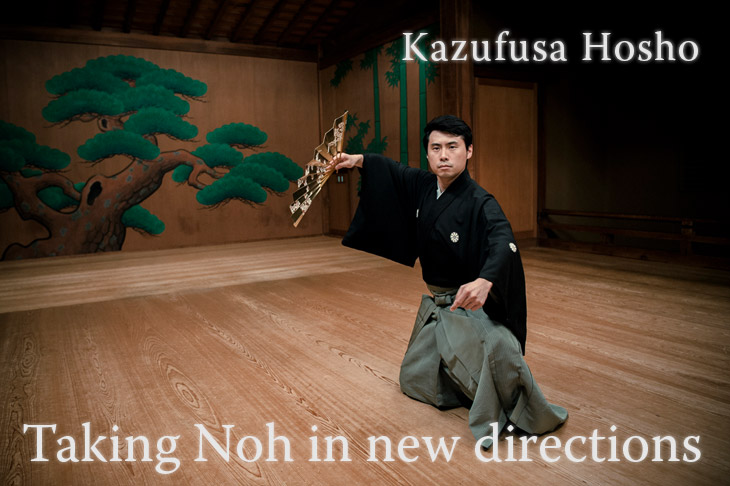
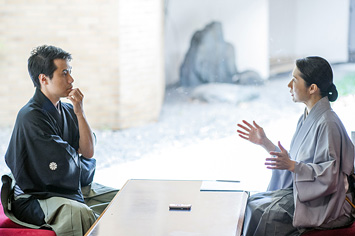
2018 marked the tenth anniversary of Kazufusa Hosho’s rise to the position of 20th Grand Master of the Hosho School, a position he inherited at the age of 22, though his beliefs and his managerial perspective remain unaltered by the passage of time. Listening to Hosho explain his logical reasoning had the scales falling from my eyes on numerous issues during our interview. The can-do spirit of this Grand Master is breathing new life into the world of Noh and opening up a host of new possibilities. (March 2019)
![]() Part 1: Managing Noh as a business
Part 1: Managing Noh as a business
![]() Part 2: Ensuring the survival of Noh (for future generations)
Part 2: Ensuring the survival of Noh (for future generations)
Interviewer: Kinue Oshima (Noh actor of the Kita School)
Photography: Shigeyoshi Ohi
Part 1: Managing Noh as a business
Following ten years as head of the Hosho School
Oshima: It’s been a decade now since you took over as head of the Hosho School, a position that I’m sure has brought both struggles and rewards. Having reached this milestone, could you tell us what you feel has changed for you during this time and what things have remained constant?
Hosho: I was 22 when I took over as head of the family, at which time, Hajime Sano, my former teacher told me: “Spend the first five years listening to people from all walks of life, then you’ll be ready to start work”. Those words stayed with me, and whilst I started WANOKAI as a separate theater troupe from the Hosho Noh Theater early on in my career, those first five years were ultimately dedicated to my growth as an individual. In all honesty, I did little or none of the work that goes with being family head in those first five years. Thinking back on it, I spent the years of my iemoto (family head) apprenticeship trying my hand at various things but the mistakes I made gave me a broader perspective on the world. I began to be given more work to do as iemoto in my fifth year as head of the family. I suspect my teacher had anticipated that when he said those memorable words to me. I was also able to draw on my failures in my work as the public face of the Hosho Noh Theater. I’d say I established my style as a performer around this time. As I see it, I’m half Noh actor, half (business) manager. Switching between these two roles is something I feel I’m uniquely capable of and it’s how I continue to approach my role today. Having put down roots, I next had to establish a balance, but I didn’t really get going until I was in my thirties.
Oshima: Is that so?
Hosho: One thing that hasn’t changed is my willingness to take on new challenges. I’ve gained experience not as a Noh actor but as a member of society at the bottom of the pecking order. To give you an example, I had the opportunity to spend a year doing all kinds of administrative work for a magazine, including editing, design and production. More recently, I’ve been working in sales. I’m still a mere fledgling, but I’m in the marketing business these days, too. This has made me think about what it is that companies are pursuing, what things magazines are attempting to convey to their readers. I’ve been on the receiving end of some fairly harsh criticism, but for me it was all about giving it a go. What that’s given me is the willingness to try anything that has the potential to benefit even the more challenging of noh performances. What’s changed is that I now think very carefully about what I’m doing and for whom. As professionals, we noh actors must give the audiences we serve the consideration they deserve. Assuming the position of truth seeker or theoretician may be the proper course for an actor, but it leaves no room to take on a role in society.
Oshima: I see your point. You have gained perspectives on and awareness of the merits of running an organization. Moreover, you are constantly taking up new challenges and giving thought to the role that noh can play in society. You give the impression of having clear goals and objectives, but are these aims that you have cultivated over the years?
Hosho: It’s who I am. I’m extremely fickle and get tired of things very quickly (laughs). Nothing else matters when I’m concentrating on a performance and I tend to forget everything else when I’m exploring something new. It was this element of my personality that made me determined to adopt a policy of setting goals for myself. You could say that setting goals became part of my style, a way of developing the art of self-management.
Oshima: Your words contain some useful pointers for young people who may be feeling undecided or conflicted. People’s strengths and weaknesses are inextricably linked and that’s something that many people struggle to come to terms with. It may well have been something your position forced you to think about, but you did well to recognize that at such a young age.
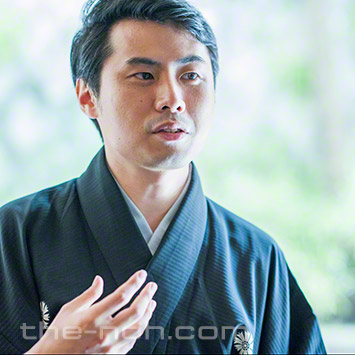
Kazufusa Hosho, 20th Grand Master of the Hosho School
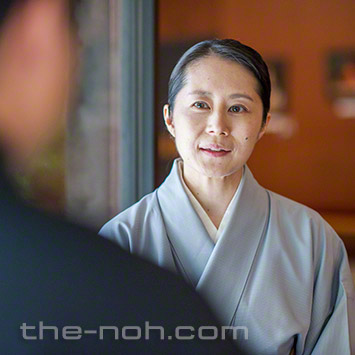
Kinue Oshima, a Noh actor of the Kita School
To watch a noh performance is to cleanse the mind: putting noh to new uses
Oshima: What would you say to someone seeing a noh performance for the first time or to someone who is unsure as to what noh theater is all about regarding the allure and enjoyment of noh theater?
Hosho: I was in my late twenties when I first began finding noh entertaining. It happens most frequently when I’m in the kōken’s (stage attendant’s) seat – a role that gives me the opportunity to think about all sorts of things in addition to my work as stage attendant. Truth be told, I love entertainment: Disneyland is one of my favorite places to spend time. Watching entertainment has the potential to change your mindset. When I realized that noh could also change people’s perspectives, I realized that it was also one “method” of making meaningful use of time. During one performance I spotted a member of the audience writing assiduous notes throughout the entire play. Afterwards, I had the opportunity to speak to him and asked him what he did. He told me that he was a designer, that he had no interest in noh and didn’t understand the performance, but that for some reason coming to the theater gave him ideas and the ability to create rough drawings, and that that was why he came. I know, too, of a writer who uses the time to think up stories, who strings together the words that come without context into his mind whilst he’s watching the performance and ends up with a complete story at the end of the play. The novelist Seiko Ito once said to me that a noh performance is like walking into a dreamscape, a remark I found highly pertinent.
Oshima: That’s certainly true, yes.
Hosho: It’s a process wherein you start by floating ideas omnibus style, and end up completing a puzzle having brainstormed all those miscellaneous thoughts into a cohesive whole. My theory is that a noh performance provides a space for brainstorming, a space to cleanse the mind.
More recently, I’ve coined the phrase “Masako Shirasu syndrome”. People in their fifties and sixties tend to view noh as an esoteric art form and thus consider it rude to think about anything other than noh during a performance. I don’t need to offer anything new to these people as they already know how to appreciate noh theater. At the same time, I don’t believe Masako Shirasu had the last word on the value of noh theater; rather, I hope to offer people in their thirties and forties, people who have numerous opportunities to brainstorm and put forward ideas, ways of watching noh that are in tune with the times. There are many who are of the opinion that anyone who is Japanese has a duty to attend at least one performance of this traditional form of Japanese entertainment, but I don’t personally believe that it’s necessary to be especially vociferous on that point.
Oshima: I’ve also encountered a number of people who have been motivated to come to a noh performance by Masako Shirasu’s book on noh theater and it is undoubtedly influential, but still.
Hosho: It was the era of cultural influencers, of people like Yukio Mishima, Akira Kurosawa, and even Donald Keene. An era when information was less readily available than it is today: the glory days for cultural encounters prompted by the reading of a book or a newspaper article written by one of these cultural influencers.
Oshima: That’s true. Shirasu’s book certainly offers a gateway into the world of noh theater, but I share your view that noh can be enjoyed in many different ways. One commentator has written that the opportunity presented by the mother (played by the shite, or lead actor) and her child in Sumidagawa to turn one’s thoughts to partings from loved ones as one watches the performance is unique to noh theater. Presenting potential audiences with the idea that it’s perfectly acceptable to muse on various thoughts and ideas whilst watching a noh performance might well convince those that put noh on the pedestal of traditional performance art that such “behavior” is also admissible.
Noh as mental training
Hosho: Looking ahead, I believe it will be necessary to divide Japan’s traditional cultures into two separate categories. It’s simply not appropriate to juxtapose noh with bunraku (puppet theater), kabuki and gagaku (ancient court music and dance). Audiences need to understand that kabuki and noh have quite different goals. Any attempt to perform them together when their goals don’t align is bound to fall apart at the seams. There’s a tendency in Japan to treat all elements of traditional culture as being equal, with the regrettable outcome that audiences are frequently left feeling bewildered as to the whole point of the undertaking when they’re staged together. I’m concerned that Japanese culture will lose its diversity if its traditional cultures are not separated into different categories. As things stand, we’ll end up with a market in which the winner will be the art form that has been most successful in upping its entertainment factor.
Without question, entertainment is the power to move emotions, but noh theater is extremely rare in that its actors are not permitted any emotional expressiveness. Developing a mind that is impervious to trivialities is a form of mental training. It’s culture as entertainment and mental training and it is the combination of these two factors that makes it possible to maintain cultural diversity. Unfortunately, we live in an era in which the entertainment-obsessed majority prevails, though I don’t believe that it’s necessary to be hostile to populism per se.
Oshima: You’re right. It’s important to remember that noh encompasses aspects of mental training, too. It was for that reason it was practiced and loved by Japanese warriors.
Hosho: In my opinion, Noh theater was one of the things that sustained Japan through its period of high economic growth. What I mean is that tumultuous times call for rational judgements, for a mental state that is unperturbed by risk. Noh is to take pleasure in striving towards that state on a day-to-day basis. Right now, it feels as if we’re being spun around in a washing machine under the excessive influence of peripheral superpowers.
It’s possible to make something of even the most unexpected of events if you handle it calmly. The reason we in the noh theater community are failing to do that may, in part, lie in the fact that we have a tendency to be blindly influenced by the entertainment market and Western culture.
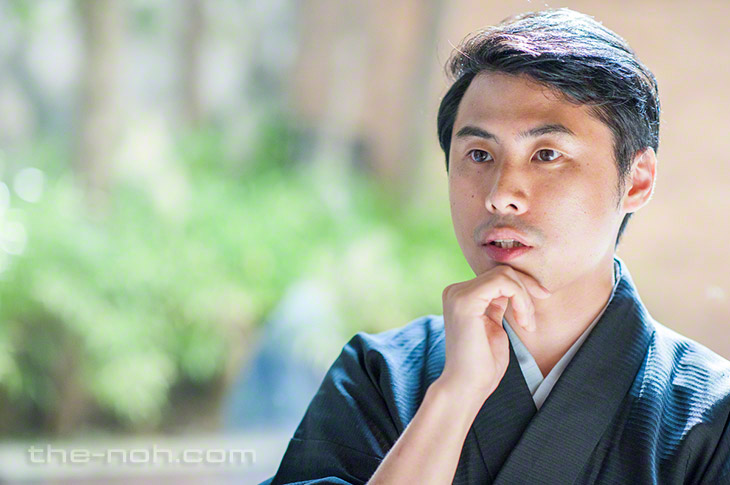
Oshima: Your profile states that you are branch advisor to the East Tokyo Branch of the Urasenke Tankokai Federation. I have also been given a little practice in the art of the Japanese tea ceremony, but I was wondering if you could tell us a little about your experience as I think the mental attitude involved in enjoying the tea ceremony shares something with that of a noh performance.
Hosho: I believe the tea ceremony and noh to be similar, though the ways in which the two arts are managed differ.
I was approached by Urasenke with a request to become an advisor and accepted based on my theory that since the underlying purpose of the foundation is identical to my own I could work with them.
Most performing arts aim for a business-to-consumer model. There are providers and customers (theater goers): the customers buy tickets and merchandise, the profits from which are used by us – the providers – to put on subsequent performances. This is something that noh theater struggles with, but its power lies in business-to-business transactions. In short, it connects business people (people in the business) and contributes to the development of human resources. I felt that a similar approach was being adopted towards the ceremonial practice of tea: B2C is naturally a key element, but it is also possible to build a solid platform for the B2B element, too. It’s another area in which the noh theater community stands to learn a great deal.
The stage is a place for experimentation. Giving myself more to “unlock”
Oshima: My next question relates to your role as a noh performer. It goes without saying that you are working to refine your own art, but you are also a teacher. Is there anything particular that you focus on when performing on stage or giving lessons?
Hosho: Yes, perhaps we should return to the sensibilities of the noh performer (laughs).
I’m not skilled enough to do both at once and so I’ve learned to create priorities for myself as a teacher. My highest priority at the moment is self-discipline. Any teacher who has no real understanding of the art but adopts an air of superiority when giving instructions risks having his teaching backfire on him. It’s important to learn established routines from those who have inherited this art from my father and I get help with this from my own teachers. My hope is that learning with other students will help me to become a better mentor in the future.
At one time, I was taking lessons from as many as five teachers simultaneously: Hajime Sano, who I mentioned earlier, Izumi Mikawa, Yasuo Imai, and several teachers at Tokyo University of the Arts. I had lessons four or five days a week. As might be expected, different teachers told me different things. That meant I needed to change my style depending on the day and I developed the habit of thinking: “I need to do it this way as this teacher will be cross if I do this.” This gradually became a pleasure in and of itself: my practice became a game of seeing just how far I could push my teachers, what I could get away with without angering them, whether I could escape without a scolding when trying certain things.
Oshima: I imagine that was a lot of fun (laughs), but I think I understand your motives, too.
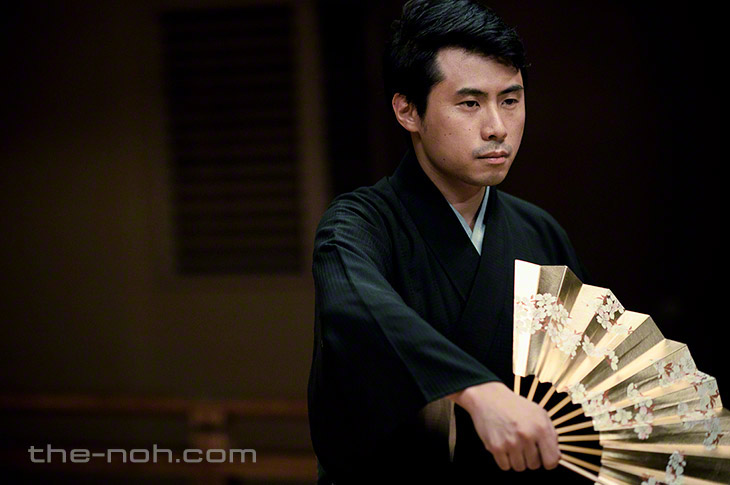
Hosho: It enabled me to pull more out of myself, certainly. I learned to switch between styles depending on the play or when I was feeling hesitant, and that’s a skill I continue to draw on today. For me, what’s important is to listen to the words of various different people and to lock those words away for later use.
I started from a place of rejection. I was told things like: “You’re no good” or “Seriously, you’re the worst actor in the noh theater community today”! Accordingly, I was driven by a spirit of defiance, by the desire to discover what I needed to do to win that individual’s praise, to put on performances that would convince them otherwise, would prove them wrong. That said, when you face up to another human being in earnest, it’s important to understand their hidden motives too, to understand, for example, that “This teacher isn’t taking about whether my kata (stylistic movement patterns) are too big or too small, he’s telling me that I need to focus on this axis (core).”
Each and every performance is a place for experimentation. Under ordinary circumstances, when you want to try an approach favored by one teacher when you’ve been using that of another to date you should do it in rehearsals, but I happen to have a lot of performances so there’ve been times when I’ve had to learn from my mistakes in the public eye, when it’s been a process of trial and error as I put the new approach into practice on stage. Rehearsals shouldn’t simply be for memorizing noh, they should also encompass a little “room” for play, I think.
Oshima: In my case, I essentially had both my father and my now-deceased grandfather to learn from and, as you say, the two men told me different things, but to have as many as five different teachers is another story completely.
Hosho: I agree. What’s more, I probably benefited from never taking lessons from my father, too.
Oshima: Now that you mention it, Roppeita Kita XIV (1874-1971) also became head of the Kita School in early childhood, learning from senior disciples to become one of the greats. Receiving lessons from various different teachers is perhaps evidence of the greatness of the expectations that are being placed on you, wouldn’t you say?
Hosho: The concept of “disciples” is a little tricky. As I see it, this industry is bottom-up. There would be no profit whatsoever without a wide base. We achieve nothing if the base dwindles, even if the head of the family is making money. Happiness for me is making other noh performers happy. For me, the ideal scheme would be one in which actions taken by the iemoto make it easier for lower ranking performers to do their work, which would bring in more disciples and more money, and insofar as there is enough to cover the license fees (the fees needed to put on a program of noh plays) then the iemoto is also happy.
Envy of the iemoto among lower ranking performers and excessive greed on the part of the iemoto are the two things most to be feared. A lot of the iemoto tend to give out little information, but that can lead to unnecessary suspicion that they’re building their own fortunes and the like. Giving rise to suspicions is extremely destructive. Money isn’t there to be saved, it’s there to be circulated and it needs to be given back in ways that are visible. Not on wining and dining, but in out-of-pocket expenses for a new project or event, for example; that’s a good relationship.
Oshima: Your sense of the need for openness is something that all leaders should aspire to. Likewise, I’d say that the concept of making things easier for your juniors is that of a manager.
Hosho: The work of the iemoto also helps to ensure the continuum. For example, even differences of opinion between regions can be settled amicably if the iemoto steps in. There are a surprising number of things that only the iemoto is capable of accomplishing, which means that it’s essential to make effective use of iemoto inevitability – the “it can’t be helped” factor or the iemoto’s final word. The work of becoming iemoto is the most meaningless part of it all. (End of Part 1) ![]()
Kazufusa Hosho, 20th Grand Master of the Hosho School (宝生和英)
Hosho was born into the Hosho household in 1986, an illustrious school of Noh performers that dates back to the Muromachi era. He made his stage debut in 1991 as a kokata (juvenile actor) in Seiōbo (Queen Mother of the West). He became head of the Hosho School in April 2008 following his graduation from the Department of Traditional Japanese Music at Tokyo University of the Arts. In October that year, he set up WANOKAI with a group of volunteers in sympathy with his ideas about Noh, an organization he presided over until its grand finale in 2018. Whilst Hosho is keen to safeguard traditional performances, he also strives to collaborate with other industries and plays an energetic managerial role in his attempt to find ways of creating new value for Noh. Hosho performs throughout Japan and is working to expand his cultural horizons overseas, mainly in Italy.
Interviewer: Kinue Oshima (大島衣恵)
Oshima is a shite-kata actor of the Kita School and a member of the Nohgaku Performers’ Association. She also teaches part-time at Elisabeth University of Music. She was born in Tokyo in 1974 and moved to the city of Fukuyama in Hiroshima Prefecture at the age of two, in wich year she made her stage debut as the Chigo (child of festivity) in Kurama Tengu (Long-nosed Goblin in Kurama. She studied under her grandfather, Hisami Oshima (3rd generation head of the Oshima School) and her father, Masanobu (4th generation head). In 1988, she became the first female actor of the Kita School to perform on stage. She has subsequently joined a number of overseas performing tours and in 2005 was awarded the Hiroshima Prefecture Culture Award. Oshima received the Hiroshima Prefectural Encouragement Award for Education in 2007, was awarded the Encouragement Award for International Exchange by the Hiroshima International Cultural Foundation in 2010, and in 2018 was given the Hiroshima Culture Award by the Hiroshima Foundation for Cultural Promotion.


